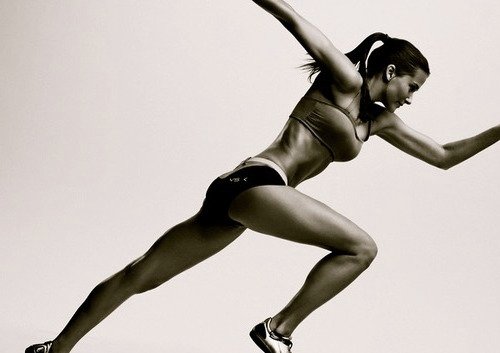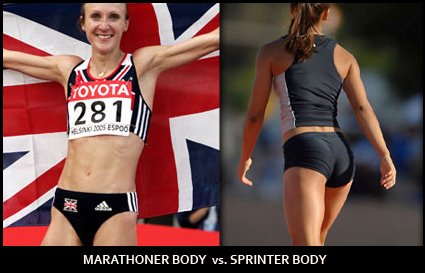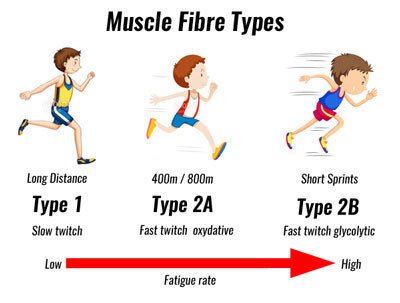The best exercise for longevity, great health and a great body

Recently I have started playing football again. I have always loved football and when I was young, I was actually very good at it. Living in Cambodia and comparing myself with the professional players, I actually think that I can be even better than them.
This lets me try and find out the fastest way to get back in shape and get the best out of myself athletically. I found this amazing training schedule: “THE HIGH INTENSITY INTERVAL TRAINING” or simply HIIT.
When you look at this picture, which body type do you think is healthier? And which figure would you rather have?

What is High Intensity Interval Training?
A definition of HIIT; a high intensity interval training is a training methodic that is meant to gain results by doing relatively short exercises.
Researchers at Laval University in Canada conducted two groups experiment. One group did a 15-week program using the HIIT while the other group did a 20-week long steady-state cardio training. The results were as follows.
- Steady-state training burned 15,000 calories more.
- Steady-state training resulted in a loss of muscle mass.
- HIIT led to significant more body fat loss.
- HIIT resulted in more calorie burns “after” the workout.
- HIIT led to muscle mass increase.
So what is wrong with steady-state endurance training?
People think that in order to lose weight and gain muscle we need to burn our calories and so to train longer. So if we exercise continuously on a similar intensity we should be able to lose fat and then create more muscles. Strangely this is not true. Steady-state training actually makes you gain more fat content and lose muscle fibers.
In order to understand this, let’s take a look at the three types of muscles fibers we have;
Type 1 (slow twitch) muscle fiber is red in color. This muscle fiber is resistant to fatigue and is capable of producing repeated low intensity contractions. Marathon runners typically have a lot of these fibers.
Type 2A (fast twitch oxidative) muscle fiber is also red in color. They are a hybrid of type 1 and type 2 fibers. When stretching the duration of a training with type 2B muscle fibers, they can become type 2A fibers. Middle long distance runners typically have a lot of these muscle fibers.
Type 2B (fast twitch glycolytic) muscle fiber is white in color. They deliver short, fast bursting of power, but become fatigue rapidly. Short distance sprinters and bodybuilders typically have a lot of these fibers.

Approximately 40 percent of our muscles consist of Type 1 fast twitch fibers. The rest around 60 percent, is of type 2A and type 2B. Doing steady-state training we are only using type 1 fiber and neglecting the other 60 percent of our muscles. If we don’t use the other two, our body has a natural tendency to lose it. That’s why steady-state training reduces muscle content of the type 2A and 2B muscle fibers. HIIT on the other hand is a complete training of all muscles, and uses all the three muscle types.
The negative effects of steady state training:
- Decrease testosterone
- Decreases immune system function
- Increases massive cortisol (the stress hormone). Our ancestors were probably never used to running for long distances on the same speed.
- And decreases in muscle content
2 Amazing benefits of doing HIIT.
1. Your body produces significantly more Human Growth Hormone.
This amazing hormone has tremendous benefits to our body. Growth hormone (GH), also known as somatotropin (or as human growth hormone [hGH or HGH] in its human form), is a peptide hormone that stimulates growth, cell reproduction, and cell regeneration in humans and other animals. It is thus important in human development.
As we get older our body creates less and less HGH. But by doing 8 weeks of high intensity training our body can boost the HGH level by more than 600 percent.
2. Increases longevity
Our DNA is structured in long strands in a certain x structure called chromosome. At the end of the X shape there is the telomere. The telomere is an extremely precise indicator of our biological life. The younger and healthier we are the longer are the telomere strands. The older and unhealthier the shorter the telomere. When putting stress to our body it has a shortening effect on the telomere. Like eating unhealthy food, smoking toxic fumes, or just overstressing ourselves. Doing HIIT, it slow downs the shortening of the telomere and even regrows it. “Reversing the aging process.”

So how to perform the HIIT?
If planning to do a HIIT training, always start with a warming up. HIIT training can be done with almost any exercise. Swimming, running, jumping, push-ups, plyometric exercises, incorporated with weights, etc. The key of the training is that you push your body to the upper limits of its strength. You keep doing this until your body signals that it cannot go anymore. This can be 10 seconds sprinting, cycling for 30 seconds or doing push-ups lasting maybe 20 seconds. After this take (depending on the state of your fitness) between 15 to 90 seconds rest, and then start over again. If you will, you can even change or mix exercises. Do this from 3 (for starters) to 8 repetitions (for advanced).
- Exercise at nearly 100% speed and power
- 15-90 seconds recovery period
- 3-8 times of repetitions
After the training you need to recover 2 or 3 days. Enough rest is needed to let your muscles repair itself. It’s best not to do HIIT training more than 3 times a week.
Thank you for reading.
----------------------------------
Hello @chhayll,
The @robinhoodwhale initiative has chosen your post as one of our top picks for curation today.
Learn more about the Robinhood Whale here!
Please keep on Steeming more great blogs!
Goodluck!
~RHW~
Hello @robinhoodwhale.
That's so nice to hear. I have read about the robinhoodwhale initiative. And I find it great that an account is dedicated to help new authors gain more visibility.
Hi Chhayll, I really like this article especialy the hiit part. I used to do crossfit where we aso had HIIT sessions. Followed you and hopefully more sport articles will follow:)
Although in general I do agree that the statements in the post are correct and backed by scientific results there's more to it than that. While HIIT is a very good form of exercise you are taking marathon runners and bodybuilders in this case (which are the extremes of each type) vs people looking to get healthier or gaining that beach body look.
Let's see the other side of the story
Note : I have a degree in Physical Education and Sports Science and am a Track and Field Throws Specialist
Muscle type fibers while % wise are usually uniform across the general population world class athletes with good/long-term training (10-12 years) vary a small % wise but big enough to make a difference in their relevant sports.
A marathon runner looks to increase VO2 Max for his specific sport. Using HIIT (year round) in the programming will not gain the needed results to be competitive in the sport. The heart also evolves differently to be able to pump more blood (and oxygen) with less pulses to the muscles (thinner walls).
An olympic weight-lifter or powerlifter looks to increase fast twitch muscles to a degree which HIIT might even hinder their performance unless they need to drop a weight-class fast or are in the start of a programming cycle. The heart in these athletes also evolves differently to be able to pump blood faster to the muscles (thick walls).
Hello @repholder,
Thanks for your reply. The type of training is indeed dependent on the goal that you set for yourself and to which sport your focus lies. Our body adapts differently to the way we exercise. A marathon runner's heart needs to function differently than short distance sprinters. I have taken two extreme examples so people can see the difference quickly. But nevertheless HIIT exercises can be a great tool for people who want to achieve good shape, build muscles, and get good health.
Nice post on HIIT. A lot of runners don't understand how beneficial it can be when included in moderation in their usual training programs.
Yes. I just started doing it, and I've already seeing some improvements. :)
Awesome! It really does deliver some great results when done appropriately, need a good diet to effectively repair the extra muscle damage it causes though.
Good luck with the training.Following you for updates :)
Thank you @karenb54. I will do my very best. :)
I am sure you will :)
Great post and on point. I use this method mixed with a type of training I learnt from training at the UFC gym. I made a modified version of it for at home. Been off the fitness train for a while and starting again tomorrow, no more excuses. I will be posting it so it helps me back on track faster. I think when fitness becomes part of your life and you stop for a while, you just can't get back on track unless you feel fit again. Fit for life!!.....Followed.
The best exercise? You misspelled barbell squat :)
Great post. I enjoyed it :)
yes. since I discovered HIIT, I stopped doing cardio (too boring). After HIIT, I continue working with weights :)
Hi, Lem. Nice article and good luck with your training. I will follow your advice and do some HIIT tomorrow.
Thanks. Hope you will do well with the HIIT. :)